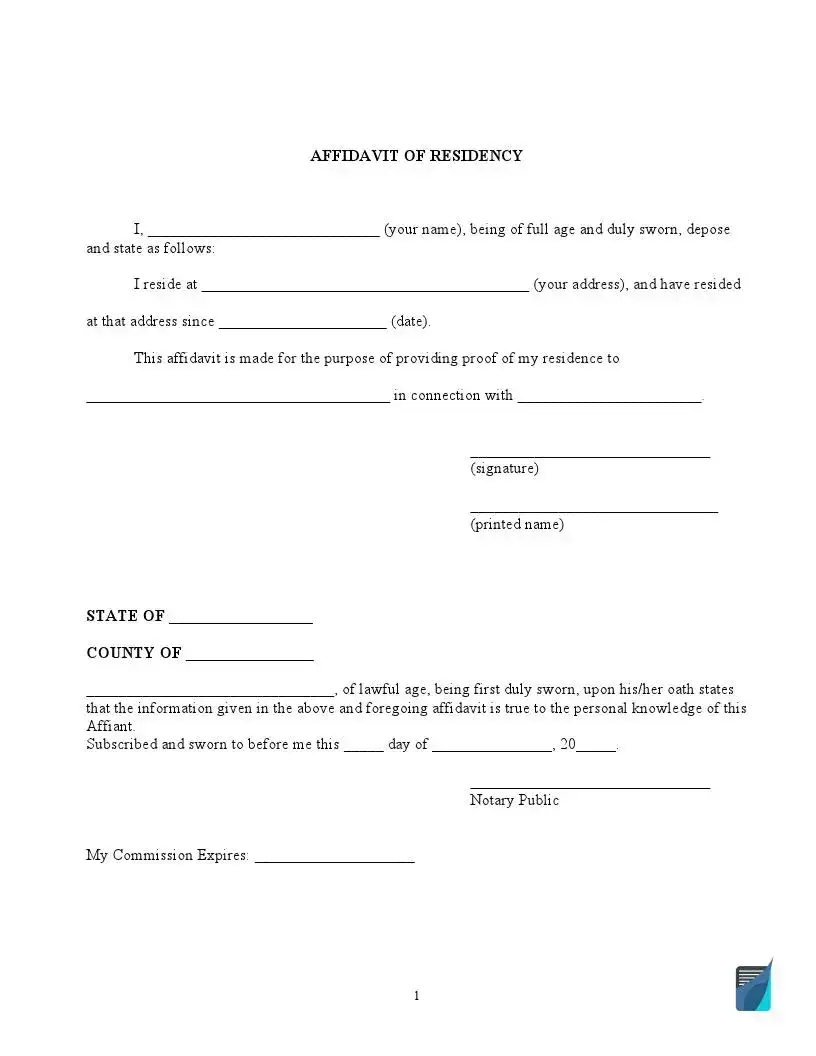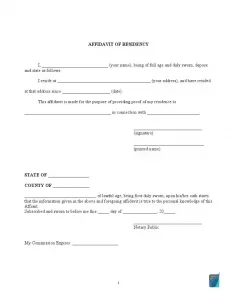Affidavit of Residency
An affidavit of residency (or proof of residency letter) is a written factual statement of a person about residing at a certain address that might be required by a court, financial institution, or business. It is a legal document that is used to prove your residence or residence of a person who lives or has lived with you.
A person making an affidavit form is called the affiant.
An affidavit of residence might be notarized, especially in situations where there is no supplemental evidence. For instance, it is recommended to involve a notary public if you are in the process of getting a driver’s license or paycheck stubs. Having an affidavit notarized is not a legal requirement, but signing an affidavit of residence with a notary acknowledgment attached helps verify the identity of the author.

Build Your Document
Answer a few simple questions to make your document in minutes
Save and Print
Save progress and finish on any device, download and print anytime
Sign and Use
Your valid, lawyer-approved document is ready
Why Need an Affidavit of Residency?
The situations where an affidavit of residence is most commonly used are:
- When an individual wants to get a driving license at a local DMV and needs to prove they are a resident of the state
- When a parent needs to confirm their child lives in their home
- When a student wants to apply for in-state tuition and needs to confirm to a school they have been living or currently dwell at a certain address
- When a person needs proof of being employed in a certain area
- When a tenant needs proof from their landlord that they have been living in a rental unit for a certain amount of time
- When a person is required by a court to claim residency in a sworn statement that should be notarized
- When there is a need to verify the residency of a deceased family member before releasing this person’s accounts or funds
How to Prove Your or Somebody’s Residence
When there is a need to prove a resident’s address, the burden of getting supplemental evidence lays on the resident. They should gather as many documents and personal testimonies as possible, but it also depends on the nature of a residence they need to prove. For instance, a local DMV will require only proof of current residence when in the case of applying for tuition, an applicant will have to confirm that they have been living in the state for a certain amount of time.
You will typically have to take the following steps to prove your residence.
Write an Affidavit of Residence
A proof of residency letter is official evidence of an affiant that they or a person on behalf of whom they are writing an affidavit is residing at a certain address or within the state.
In situations where a residency affidavit is not needed, it is still better to supply it as it intensifies any testimony or documents that may be required to prove residency.
As well as that, an affidavit of residence contains contacts of the affiant, which might be used if any source of residence evokes hesitations.
Provide Evidence
An affiant has to add any forms that might be needed to supply the claim of residency. Among such documents might be a health insurance card, real estate deed, rental agreement, driver’s license, paycheck stub, utility bill, tax return, bank statement, vehicle title, etc. There is no need to provide plenty of evidence as several of the above-mentioned documents are typically enough to prove residency.
If there is no supplemental evidence, an affidavit has to be notarized.
File the Affidavit of Residence and Supporting Documents
The last step is to file an affidavit of residence along with the supporting documents with the requesting body. Once they are accepted, the body will return them to the affiant.
What to Write in an Affidavit of Residency
An affidavit of residence is a relatively simple document to create. With a plethora of templates that can be found online, all you need to do is to use one of them and fill it out according to our instructions. Or, you can use our online builder, which will offer you to answer several questions and based on your answers, will fill the form on its own.
Before creating an affidavit of residence using any of the available methods, first, answer several questions:
- For what period of time have you been living in the state/county?
- Who is living with you now?
- At what address will the affidavit of residence be signed?
By responding to these questions, you can streamline the process of creating the document. After you have filled out a proof of residency letter properly, you need to find a notary public and finalize the document this way.

How to Fill Out an Affidavit of Residence
Considering that a proof of residence letter is a relatively easy legal document to fill in, you will have to take only a few steps.
Step 1 – Information about the signing party
In the upper left-hand part of the first page of the document, write down your name and address. Beneath this information, there should be an effective date of the legal document.

Step 2 – Legal statement
The next thing in an affidavit of residence should be the declaration. It should start with you turning to a person in charge with the words like “To whom this might concern”. Then, there should be a legal acknowledgment of your residence. The following wording might be used: «I [Your name] formally acknowledge living at the street address of [Name of your street], City of [Name of your city], State of [Name of your state] since [Date of the official beginning of residence at the specified address]”.
Step 3 – The list of supporting documents
In the next paragraph, you should tell that you attached each and every legal document needed using the similar wording: “I have attached the following documents for your consideration”. Then, every legal document required by the financial institution, court, or business entity should be added.
Step 4 – Signature
The affidavit of residence should end with “sincerely” and your signature.

Step 5 – Witness acknowledgment
The next page of the affidavit of residence should be the witness acknowledgment. It should tell that witness or witnesses acknowledge that it was you who created the document. To validate the acknowledgment, they should put their signatures, dates of signing the acknowledgment, and print names.
Step 6 – Notary acknowledgment
After putting signatures of witnesses in the document, the proof of residency affidavit might need authorization by a notary public. Notary acknowledgment goes as the last page of the affidavit of residence, and it should state that you personally appeared before the notary public and executed the legal document.
